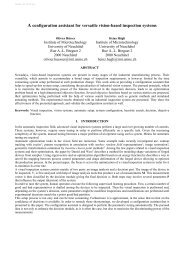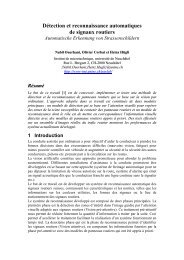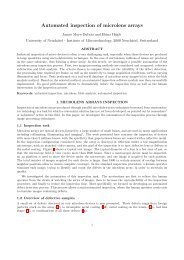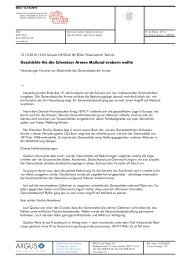Continuous Wavelet Transform on the Hyperboloid - Université de ...
Continuous Wavelet Transform on the Hyperboloid - Université de ...
Continuous Wavelet Transform on the Hyperboloid - Université de ...
Create successful ePaper yourself
Turn your PDF publications into a flip-book with our unique Google optimized e-Paper software.
We now have all <strong>the</strong> basic ingredients for formulating a useful c<strong>on</strong>voluti<strong>on</strong><br />
<strong>the</strong>orem in <strong>the</strong> Fourier-Helgas<strong>on</strong> domain. As we will now see <strong>the</strong> FH transform<br />
of a c<strong>on</strong>voluti<strong>on</strong> takes a simple form, provi<strong>de</strong>d <strong>on</strong>e of <strong>the</strong> kernels is rotati<strong>on</strong><br />
invariant.<br />
Theorem 3 (C<strong>on</strong>voluti<strong>on</strong>) Let f and s be two measurable functi<strong>on</strong>s, with<br />
f,s ∈ L 2 (H+) 2 and let s be rotati<strong>on</strong> invariant. The c<strong>on</strong>voluti<strong>on</strong> (s ∗ f)(y) is in<br />
L 1 (H+ 2 ) and its Fourier-Helgas<strong>on</strong> transform satisfies<br />
̂ (s ∗ f)(ν, ξ) = ˆf(ν, ξ)ŝ(ν). (57)<br />
Proof : The c<strong>on</strong>voluti<strong>on</strong> of s and f is given by:<br />
∫<br />
(s ∗ f)(y) = s([y] −1 x)f(x)dµ(x).<br />
H 2 +<br />
Since s is SO(2)-invariant, we write its argument in this equati<strong>on</strong> in <strong>the</strong> following<br />
way :<br />
⎛<br />
⎞ ⎛ ⎞ ⎛<br />
⎞<br />
cosh χ − sinh χ 0<br />
x 0<br />
x 0 cosh χ − x 1 sinh χ<br />
⎜ − sinh χ cosh χ 0<br />
⎟ ⎜ x 1<br />
=<br />
⎟ ⎜ −x 0 sinh χ + x 1 cosh χ<br />
, (58)<br />
⎟<br />
⎝<br />
⎠ ⎝ ⎠ ⎝<br />
⎠<br />
0 0 1 0<br />
0<br />
where x =(x 0 ,x 1 ,x 2 ) and we have used polar coordinates for y = y(χ, ϕ). On<br />
<strong>the</strong> o<strong>the</strong>r hand we can alternatively write this equati<strong>on</strong> in <strong>the</strong> form :<br />
⎛<br />
⎞ ⎛<br />
⎞ ⎛ ⎞<br />
x 0 cosh χ − x 1 sinh χ<br />
x 0 −x 1 0<br />
cosh χ<br />
⎜ −x 0 sinh χ + x 1 cosh χ<br />
=<br />
⎟ ⎜ −x 1 x 0 0<br />
⎟ ⎜ sinh χ<br />
. (59)<br />
⎟<br />
⎝<br />
⎠ ⎝<br />
⎠ ⎝ ⎠<br />
0<br />
0 0 1 0<br />
Thus we have<br />
s([y] −1 x)=s([x] −1 y). (60)<br />
Therefore, <strong>the</strong> c<strong>on</strong>voluti<strong>on</strong> with a rotati<strong>on</strong> invariant functi<strong>on</strong> is given by<br />
∫<br />
(s ∗ f)(y)=<br />
∫<br />
=<br />
H 2 +<br />
H 2 +<br />
f(x)s([y] −1 x)dµ(x) (61)<br />
f(x)s([x] −1 y)dµ(x). (62)<br />
17
















